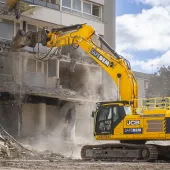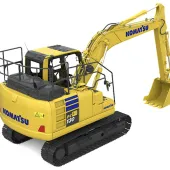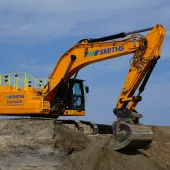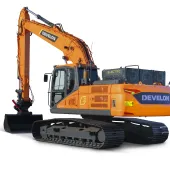New Komatsu Hybrid Excavator

First published in the November 2014 issue of Quarry Management as Combined Power
Marubeni-Komatsu introduce the new fuel-efficient third-generation Komatsu HB215LC-2 Hybrid excavator to the UK market
Komatsu introduced the world’s first hybrid excavator in 2008 and, since then, have sold more than 2,600 hybrid machines worldwide. The HB215LC-2 Hybrid hydraulic excavator, released into the UK market this year by Marubeni-Komatsu, is based on iterations of Komatsu’s hybrid experience and represents the ‘third generation’ of the company’s revolutionary hybrid model.
According to Jim Venerus, deputy general manager for European product marketing at Komatsu Europe, customer satisfaction is the rule, and Komatsu hybrid technology is widely recognized as reliable and efficient by owners and operators in Europe and around the world. ‘The Komtrax monitoring system, standard on Komatsu models, shows that our customers are achieving, on average, 25% fuel savings with their Komatsu hybrid machines, along with a significant reduction in CO2 emissions. And by refining our hybrid technology, we have further improved fuel efficiency on the new HB215LC-2 machine,’ he said.
Yoshihiro Kobayashi, product manager for hybrid excavators at Komatsu Europe, confirmed: ‘The new HB215LC-2 will provide Komatsu customers with even greater fuel economy. Actual savings will depend on the application, but fuel efficiency is particularly high when operating the excavator with hydraulic attachments. We estimate that the extra investment in a Komatsu hybrid machine can typically be recovered in two years or less.’
The HB215LC-2 is supported by Komatsu CARE, a complimentary maintenance programme for Komatsu customers that comes as standard with every new Komatsu EU Stage IIIB construction machine. It covers factory-scheduled maintenance, performed by Komatsu-trained technicians with genuine Komatsu parts, for the first three years or 2,000h. Moreover, there is no scheduled replacement interval for the Komatsu Diesel Oxidation Catalyst (KDOC) on the HB215LC-2. The integrated design of the KDOC ensures longevity and allows this simple system to remove soot using 100% ‘true passive regeneration’, without the need for a diesel particulate filter (DPF).
The HB215LC-2 is powered by the revolutionary Komatsu hybrid system, which works on the principle of swing energy regeneration and energy storage (see page 16 for further details). It includes Komatsu’s electric swing motor, power generator motor, ultra-capacitor and a 104kW (139hp) SAA4D107E-2-A diesel engine. All the hybrid components on the new HB215LC-2 are covered by a five-year or 10,000h special warranty.
For the operator, the new ROPS-certified cab provides a more comfortable and quieter work environment to help maximize productivity. The cab is mounted on viscous isolation dampers that ensure low vibration levels, while a higher-capacity air-suspension high-back seat and heating are standard, for improved comfort. In addition to the standard radio, an auxiliary input for connecting external devices is provided to play music through the cab’s stereo speakers. Two additional 12V power ports are also incorporated in the cab.
A high-resolution 7in LCD colour monitor featuring enhanced capabilities allows the operator to easily select up to six working modes to match machine performance to the application. The monitor panel provides information on ECO guidance, operational records, fuel consumption history, and utilization information. A standard rear-view camera with a wide landscape display allows the operator to view directly behind the machine.
For further information about the new HB215LC-2 Hybrid visit: www.marubeni-komatsu.co.uk
How does hybrid technology work?
Everyone has heard of hybrid cars where a traditional combustion engine works alongside an electric motor. Energy that is generated by the car, eg through braking, is captured and stored in a battery. This energy can then be used by the electric motor to aid the engine, ie when needed for acceleration.
Although the hybrid technology in an excavator is not quite the same, the overall principle is not dissimilar. Think of an excavator that has a loaded bucket and then the upper structure is rotated to where the material is to be unloaded, then rotated back around again to pick up more material. During this process the operator needs to slow down the upper structure to get it into the correct position. It is during this slowing down or ‘braking’ phase that the energy generated is captured and stored. This energy is released at a later stage, to support the diesel engine during an acceleration phase.
Komatsu hybrid technology
The Komatsu hybrid system for excavators works on the principle of swing energy regeneration and energy storage. The kinetic energy generated during the swing-braking phase of the excavator’s operation is harvested, converted to electricity and stored for future re-use. When accelerating under workload conditions the captured energy is discharged quickly for upper structure rotation and to assist the engine as needed. The reserve power stored by the hybrid technology represents additional horsepower that is available to maximize machine performance by supporting the engine, or is used to boost swing power. All the major hybrid components are manufactured by Komatsu, including the electric swing motor, power generator motor and ultra-capacitor.
Key hybrid components
Electric swing motor
The electric swing motor recovers the energy generated during swing braking and produces electricity. This electric motor is used instead of the usual hydraulic swing motor. This electricity is sent through an inverter and captured by the ultra-capacitor.
Inverter
The inverter switches the AC electricity received from the swing motor into DC electricity and passes it on to the ultra-capacitor for storage.
Ultra-capacitor
The ultra-capacitor provides fast energy storage and instantaneous power transmission. Since capacitors use the migration of electrons and ions for charging and discharging, they can transfer power much faster than batteries, which use chemical reactions to produce electricity.
Generator motor
The generator motor is positioned between the engine and hydraulic pumps. The generator produces electric power to charge the capacitor as needed. The generator motor also uses electricity from the capacitor to provide power to assist the engine as required.
Control system
All energy flows are automatically controlled by the onboard system, so that energy capture and release are optimized. The operator can view the real-time power flow between the components and engine, as well as fuel usage, via a monitor inside the cab.
Maximizing fuel savings
Using the captured and stored electric energy to support the engine results in reduced fuel consumption and fewer CO2 emissions. As already mentioned, the energy is mostly generated via braking during the rotational movements of the upper structure. Thus, if a hybrid excavator is used on a job which involves a lot of slewing, the fuel saving will be greater than if the machine is used on applications that involve significantly less slewing.
This has been borne out by customers operating the previous version of the Komatsu Hybrid, the HB215LC-1. For example, in a quarrying operation where the excavator sits on a stockpile loading material into a washer for most of the day, there is a tremendous amount of slewing involved. Customers who have used the hybrid machine for such an application have reported fuel savings far in excess of those quoted by Komatsu for a machine with a more typical working pattern.
- Subscribe to Quarry Management, the monthly journal for the mineral products industry, to read articles before they appear on Agg-Net








